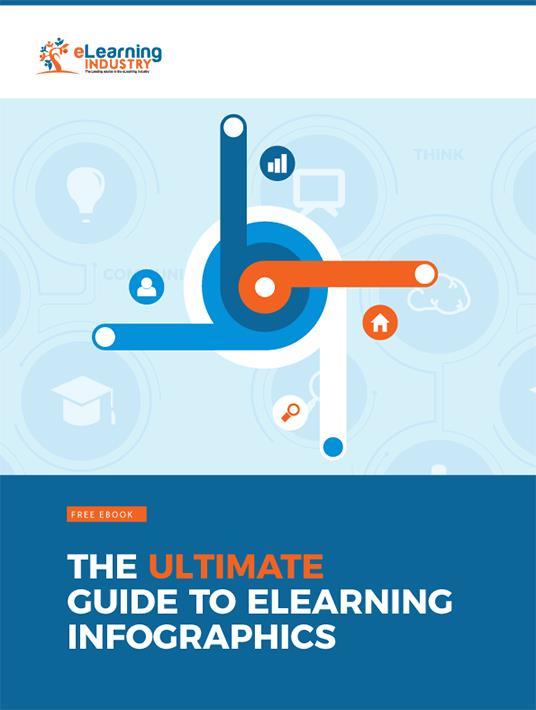eLearning Inforgraphics: How To Use Them In eLearning
Everyone’s heard the saying, “A picture is worth a thousand words”. But nowhere is it more apt than in eLearning. Incorporating eLearning infographics into your eLearning strategy adds enjoyment to the learning process. eLearning infographics help with memory retention and may increase overall eLearning course completion. Here are 5 eLearning infographics facts to consider.

1. There’s More To It Than Simply Converting A PowerPoint Presentation
A quick look at a few eLearning infographic presentations shows a similarity between eLearning infographics and PowerPoint slides. The eLearning infographics are the slides stacked in vertical columns instead of scrolling horizontally. However, a direct conversion from PowerPoint slide deck to eLearning infographic isn’t usually the best approach. It is possible for part of the text to be left out, and a picture or cartoon inserted instead to represent the missing data. When you design your eLearning infographic, you organize the main topic into subtopics. Each subtopic represents a stacked slide. This implies a tightly focused point often aligned around a pictograph. The text is memorable because it is associated with the picture.
2. Less Is More
An eLearning infographic is about one topic. However, the broader the topic, the harder it will be to narrow down the subtopics. If you find yourself in this position, you may want to consider making individual eLearning infographics on the subtopics instead. For example, let’s say your topic is about trees. What type of tree is it? What region is it native in? What are its growth requirements? What are the diseases or pests that prey on it? What is it used for? The questions are really endless. However, if you refined the topic to “The aerial root formation of the Sri Maha Bodhi, or Banyan tree makes its own forest”, the focus is clear. That said, it’s also possible to unify complex ideas. What do you do if the topic is just too involved or you want to combine two ideas into a solution path? eLearning infographics can show a logical path and learning stream between the ideas to give online learners the “ah ha” moment.
3. Let Your Pictures Do the Talking
Humans are visual beings. 90% of the communicated information is visual [1]. So let the eLearning infographic pull the reader in and be the bait. However, coming up with this visual hook is a true art form. So, what is the best strategy for finding this “perfect” lure? It’s all in the data. Let your data be your muse, all the elements are there. What is it saying? Can you see a picture form? This is your eLearning infographic. The picture is formed and you know what it will look like, but you still need to be cautious about color. Too much color and you lose the main focus of the eLearning infographic, which is learning. Try to limit the colors to just a few. Use a central color to separate sections, then use complimentary colors for the different panes. Also make sure the color choices don’t overpower and take over from the actual text message. The overall goal is learning, not entertainment.
4. Legibility Trumps Artistic Expression
When formatting the text on eLearning infographics, find a font that is interesting, yet easy to read. Most official documents are commonly published in either Times New Roman or Arial. Don’t be afraid to experiment with other fonts, though. Let the font work with the graphics to enhance or convey the meaning of the words. It can be used as a “visual voice”. You can also vary the text size within the presentation. If a point really needs to be highlighted, your tool kit is your imagination. Play with bold, italics, underline, a bold color choice, and even a different font for that word. As a word of caution though, too much of a good thing is still too much. Choose one or two creative ways to draw attention to a word, or phrase, but no more than that. And remember, always ask yourself whether it’s readable on every device.
5. No Graphic Design Experience Required
You may fall into one of two categories: artistically challenged or too busy to try. This is where clip art or icons come into play. There are all sorts of free icons available. When you add icons or clip art to the eLearning infographic, they must all be of the same style. Otherwise the overall look will be jarring. You can also opt for an authoring tool that features a vast asset library. Don’t pay any heed to the common myth that eLearning infographics are only for the artistically inclined.
You don’t have to be a graphic designer to create eLearning infographics. Let your imagination and the text message work together to form an image. Then look through free icons or clip art to find a visual match and play around with color, font, size, etc. Above all, let these 5 eLearning infographics tips be your guide.
Want to learn more about eLearning Infographics? Download our Free eBook: The Ultimate Guide To eLearning Infographics to discover how to work with eLearning Infographic templates, the benefits of including eLearning Infographics into your eLearning course design, the steps you should follow to create them, as well as examples of creative uses and must-have features that exceptional eLearning Infographics usually include.
References:






